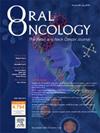头颈部癌症的机器人辅助颈部切除术与传统颈部切除术:系统综述和荟萃分析。
IF 4
2区 医学
Q1 DENTISTRY, ORAL SURGERY & MEDICINE
引用次数: 0
摘要
背景:技术的进步使得颈部解剖技术在保持肿瘤安全性的同时减少了对美观的影响。本研究比较了通过耳后/改良拉皮切口(RNDRM)进行机器人颈部解剖与通过颈前侧切口(CND)进行传统颈部解剖的围手术期结果:研究选自 PubMed、Embase 和 Cochrane 图书馆。从比较 RNDRM 和 CND 的研究中提取数据,并使用随机效应模型进行分析:荟萃分析包括 8 项研究,共 421 个病例。RNDRM组的手术时间更长(平均差异[MD],69.11;95%置信区间[CI],37.92~100.30),美容满意度更高(MD,2.03;95%置信区间[CI],1.48~2.57),下颌神经边缘损伤的风险更高(风险差异[RD],0.08;95%置信区间[CI],0.01~0.15)。在手术失血量(MD,15.35;95 % CI - 7.39 至 38.10)、引流管放置天数(MD,0.49;95 % CI,-0.02 至 1.00)、引流量(MD,15.29;95 % CI,-45.22 至 75.79)、总体淋巴结产量(MD,-1.09;95 % CI,-3.18 至 1.00)、淋巴结阳性率(MD,-0.61;95 % CI,-2.20 至 0.98)、住院时间(MD,1.07;95 % CI,-0.06 至 2.20)或区域复发(RD,0.00;95 % CI,-0.05 至 0.05),其他并发症发生率相似:结论:与 CND 相比,RNDRM 具有更好的美容效果,但需要更长的手术时间,而且下颌神经边缘损伤的风险更高。对于选定的患者来说,RNDRM 可能是一种替代方案,但手术方式的选择需要患者和外科医生进行讨论。本文章由计算机程序翻译,如有差异,请以英文原文为准。
Robot-assisted versus conventional neck dissection in head and neck cancers: A systematic review and meta-analysis
Background
Advances in technology have enabled neck dissection techniques that reduce aesthetic impact while maintaining oncological safety. This study compares perioperative outcomes between robotic neck dissection via retroauricular/modified facelift incision (RNDRM) and conventional neck dissection via anterolateral cervical incision (CND).
Methods
Studies were selected from PubMed, Embase, and Cochrane Library. Data from studies comparing RNDRM and CND were extracted and analyzed using a random-effects model.
Results
The meta-analysis included eight studies with 421 cases. The RNDRM group had a longer operative time (mean difference [MD], 69.11; 95 % confidence interval [CI] 37.92 to 100.30) and higher cosmetic satisfaction (MD, 2.03; 95 % CI, 1.48 to 2.57), along with a higher risk of marginal mandibular nerve injury (risk difference [RD], 0.08; 95 % CI 0.01 to 0.15). No significant differences were found in operative blood loss (MD, 15.35; 95 % CI − 7.39 to 38.10), days of drain placement (MD, 0.49; 95 % CI, −0.02 to 1.00), drainage volume (MD, 15.29; 95 % CI, −45.22 to 75.79), overall lymph node yield (MD, −1.09; 95 % CI, −3.18 to 1.00), positive lymph node yield (MD, −0.61; 95 % CI, −2.20 to 0.98), length of hospital stay (MD, 1.07; 95 % CI −0.06 to 2.20), or regional recurrence (RD, 0.00; 95 % CI −0.05 to 0.05), with similar rates of other complications.
Conclusion
RNDRM offers better cosmetic outcomes but requires longer operative time and has a higher risk of marginal mandibular nerve injury than CND. It may be an alternative for selected patients, with surgery choice needing discussion between patient and surgeon.
求助全文
通过发布文献求助,成功后即可免费获取论文全文。
去求助
来源期刊

Oral oncology
医学-牙科与口腔外科
CiteScore
8.70
自引率
10.40%
发文量
505
审稿时长
20 days
期刊介绍:
Oral Oncology is an international interdisciplinary journal which publishes high quality original research, clinical trials and review articles, editorials, and commentaries relating to the etiopathogenesis, epidemiology, prevention, clinical features, diagnosis, treatment and management of patients with neoplasms in the head and neck.
Oral Oncology is of interest to head and neck surgeons, radiation and medical oncologists, maxillo-facial surgeons, oto-rhino-laryngologists, plastic surgeons, pathologists, scientists, oral medical specialists, special care dentists, dental care professionals, general dental practitioners, public health physicians, palliative care physicians, nurses, radiologists, radiographers, dieticians, occupational therapists, speech and language therapists, nutritionists, clinical and health psychologists and counselors, professionals in end of life care, as well as others interested in these fields.
 求助内容:
求助内容: 应助结果提醒方式:
应助结果提醒方式:


